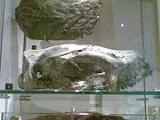
Neohelos
Encyclopedia
Neohelos is an extinct sheep-sized marsupial
from the late Oligocene
to middle-Miocene
aged deposits of Bullock Creek in the Northern Territory
, Lake Ngapakaldi South Australia
and riversleigh
of Queensland
. There are four species in this genera, N. tirarensis (Stirton 1967) from Bullock Creek and the undescribed N. spA, N. spB (Bullock creek and Riversleigh) and N. spC from Riversleigh
. There might be a fifth species from Lake Ngapakaldi Local Fauna. These are all according to Murry et al. (2000 p. 111) may form succession species with the last being the ancestor to the genera Kolopsis
.
Marsupial
Marsupials are an infraclass of mammals, characterized by giving birth to relatively undeveloped young. Close to 70% of the 334 extant species occur in Australia, New Guinea, and nearby islands, with the remaining 100 found in the Americas, primarily in South America, but with thirteen in Central...
from the late Oligocene
Oligocene
The Oligocene is a geologic epoch of the Paleogene Period and extends from about 34 million to 23 million years before the present . As with other older geologic periods, the rock beds that define the period are well identified but the exact dates of the start and end of the period are slightly...
to middle-Miocene
Miocene
The Miocene is a geological epoch of the Neogene Period and extends from about . The Miocene was named by Sir Charles Lyell. Its name comes from the Greek words and and means "less recent" because it has 18% fewer modern sea invertebrates than the Pliocene. The Miocene follows the Oligocene...
aged deposits of Bullock Creek in the Northern Territory
Northern Territory
The Northern Territory is a federal territory of Australia, occupying much of the centre of the mainland continent, as well as the central northern regions...
, Lake Ngapakaldi South Australia
South Australia
South Australia is a state of Australia in the southern central part of the country. It covers some of the most arid parts of the continent; with a total land area of , it is the fourth largest of Australia's six states and two territories.South Australia shares borders with all of the mainland...
and riversleigh
Riversleigh
Riversleigh, in North West Queensland, is Australia's most famous fossil site. The 100 km² area has fossil remains of ancient mammals, birds and reptiles of Oligocene and Miocene age...
of Queensland
Queensland
Queensland is a state of Australia, occupying the north-eastern section of the mainland continent. It is bordered by the Northern Territory, South Australia and New South Wales to the west, south-west and south respectively. To the east, Queensland is bordered by the Coral Sea and Pacific Ocean...
. There are four species in this genera, N. tirarensis (Stirton 1967) from Bullock Creek and the undescribed N. spA, N. spB (Bullock creek and Riversleigh) and N. spC from Riversleigh
Riversleigh
Riversleigh, in North West Queensland, is Australia's most famous fossil site. The 100 km² area has fossil remains of ancient mammals, birds and reptiles of Oligocene and Miocene age...
. There might be a fifth species from Lake Ngapakaldi Local Fauna. These are all according to Murry et al. (2000 p. 111) may form succession species with the last being the ancestor to the genera Kolopsis
Kolopsis
Kolopsis is an extinct genus of diprotodontid marsupials from Australia. It contains three species:*†Kolopsis rotundus Plane 1967*†Kolopsis torus Woodburne, 1967*†Kolopsis yperus Murray, Megirian & Wells, 1993K...
.
See also
- HulitheriumHulitheriumHulitherium is an extinct genus of Zygomaturidae, a marsupial from New Guinea during the Pleistocene...
- SilvabestiusSilvabestiusSilvabestius is an extinct genus of marsupial dating to the Early Miocene. They were grazing animals about the size of a modern sheep.This animal is known from two skulls found close together which have come to be known as the "Madonna and Child" fossils.Silvabestius is an extinct genus of...
- ZygomaturusZygomaturusZygomaturus is an extinct giant marsupial from Australia during the Pleistocene. It had a heavy body and thick legs and is believed to be similar to the modern Pygmy Hippopotamus in both size and build. The genus moved on all fours. It lived in the wet coastal margins of Australia and became...
- KolopsisKolopsisKolopsis is an extinct genus of diprotodontid marsupials from Australia. It contains three species:*†Kolopsis rotundus Plane 1967*†Kolopsis torus Woodburne, 1967*†Kolopsis yperus Murray, Megirian & Wells, 1993K...

